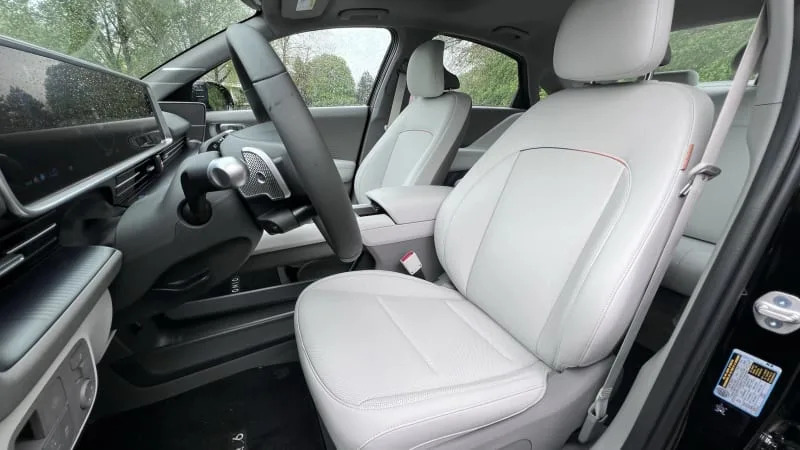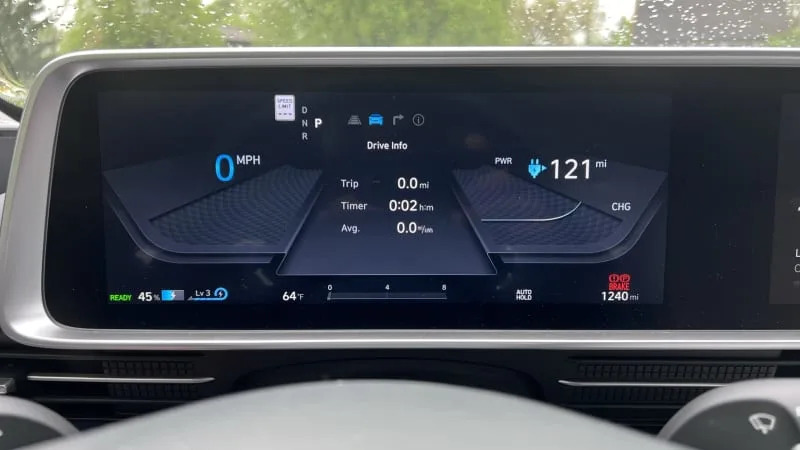2024 Hyundai Ioniq 6: The winner that could have been

When we performed our recent affordable EV comparison test pitting the Hyundai Kona Electric, Kia Niro EV, Tesla Model Y and Volkswagen ID.4 against one another, we also had a Hyundai Ioniq 6 on hand during testing and throughout the week. We didn’t include it in this comparison, as our Ioniq 6 tester came in at a total of $54,975, which was beyond our budget for this review considering a lack of an available tax credit. That’s $9,845 more than the Tesla Model Y (after the federal tax credit), and $8,215 more than the Kia Niro EV (which is not eligible for the credit). It’s a shame we couldn’t get our hands on a lower trim of the Ioniq 6 — or even an Ioniq 5 — because there’s a strong chance it could have come away as the winner.
Specifically, we had the 2024 Ioniq 6 Limited AWD, which is the priciest version you can buy. The Limited comes with the long-range battery, good for 305 miles on a charge in rear-wheel drive, or 270 miles with the dual-motor all-wheel-drive powertrain. The same RWD and AWD powertrains are available in the lesser SE trim, at $43,600 or $47,100. Thanks in part to its smaller wheels, the SE is rated at 361 miles (RWD) or 316 miles (AWD). That bests the Tesla Model Y Long Range’s 320 miles with RWD (at $46,380) and 310 miles with AWD (at $49,380).
That’s an excellent mileage value for the SE. And we’ve found in both previous drives of the Ioniq 6, as well as our recent week with the car, that it’s no challenge to meet or beat the car’s range estimates. The elephant in the room, of course, is the available federal tax credit. The Model Y is eligible for the $7,500 point-of-purchase rebate. The Ioniq 6 is not. Nor were the Hyundai Kona Electric and Kia Niro EV we tested. The Volkswagen ID.4 is, though.


The Ioniq 6 is no performance slouch either, with the rear-drive model providing 225 horsepower and the dual-motor variant making 321 hp. That’s good for 0-60 in about 7 seconds (RWD) or 5.1 seconds (AWD). It’s not quite as quick as the currently available Model Y (6.5 seconds for RWD, 4.8 for AWD), but it’s close enough to make little difference. It should be noted, however, that the Model 3 Performance pares that down to 3.5 seconds.
But where the Hyundai truly outshines the Tesla is in some of the more basic refinement and intangible realms. For one thing, the Ioniq feels more polished. It’s quieter going down the road. It doesn’t suffer from the same high-pitched electronic tone that fills the Tesla’s cabin upon acceleration. The Hyundai doesn’t exhibit any rattling or shaking, while the Tesla gives a lot of chatter over even the smallest imperfections. Materials in the Ioniq 6 SE aren’t particularly ingratiating — there’s less to complain about in the Limited — but there’s at least an attempt at some thoughtful design with its funky pixel theme, and it’s pulled off quite well. Additionally, the user interface is much easier to navigate and use, and doesn’t force a learning curve onto the user. There are plenty of features you can control without having to use the touchscreen. There’s also an easily-read instrument panel right in front of you … imagine that.
That said, the Tesla Model Y might very well have won this comparison test even with the Ioniq 6 included. It does the EV things well, even if much of the car feels a bit unfinished. In addition to good range, competitive pricing and fun driving — and possibly it wins on those alone — there’s one big advantage Tesla has over the rest of the EV industry: charging infrastructure. Tesla has a huge head start on the rest of the industry when it comes to numbers and locations. Tesla’s chargers are also easy to use and, most importantly, they tend to actually work. We noted in our comparison test that we had issues charging the other EVs with Electrify America, but had no issues with Tesla’s Superchargers. Hyundai Group’s E-GMP cars (like the Ioniqs) are among the fastest charging in the industry, but so are Tesla’s vehicles, and they use a more reliable network with excellent integrated car software that makes using the network a painless experience. If you’re going to be charging away from home often, Tesla offers peace of mind when your battery starts getting low.
If you use our EV comparison test as a guide, it might make your purchasing decision easier, but before you go out and buy that Tesla (or VW ID.4), don’t overlook the Hyundai Ioniq 6 … or the mechanically similar but more cargo-friendly Ioniq 5. One of those Korean EVs could potentially run away with our next comparo.
Related video:







